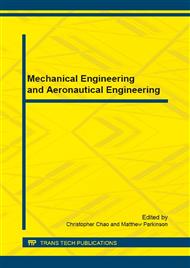p.61
p.66
p.73
p.78
p.83
p.90
p.95
p.103
p.110
The Effect on the Dry Sliding Wear Behavior of Gravity Cast A357 Reinforced with Dual Size Silicon Carbide Particles
Abstract:
In the present study, the composites of A357 (Al-7%Si) alloy reinforced with the bimodal sizes (~250µm (L) and ~38 µm (S)) of 6wt% SiCp and the A357 alloy were prepared by permanent mould die casting. Three different combinations of bimodal distributions were considered: (3% L + 3% S, 4% L + 2% S, and 2% L + 4% S). The wear behavior of the alloy and the composites was studied for the speed of 1 m/s and load conditions of 10-30 N with an interval of 5 N in a pin on disc apparatus. The hardness and microstructure of the composites were also characteristised. The results suggest that the addition of bimodal size of particles significantly improves the hardness and wear resistance of the alloy. Among the different combinations, the 4% L + 2% S bimodal distribution combination provides the highest wear resistance and the hardness. This result indicates that the higher amount of large size particles are more important than that of small size particles to improve the wear resistance, which implies that the particle decohesion is the rate controlling step in the present investigation. The wear rate increases with an increase of load and sliding distance. The critical load to enter into the severe wear regime for the alloy and composites is 25 N. The rapid wear loss begins above 1500 m sliding distance in the composites and the as cast alloy. The wear rate curve with respect to the sliding distance shows three regimes (1) transition period (2) steady state (3) severe wear state. The wear morphology studies show that the abrasive wear is the main wear mechanism in the bimodal size composites whereas the delamination wear is predominant in the alloy.
Info:
Periodical:
Pages:
83-89
Citation:
Online since:
March 2016
Authors:
Price:
Сopyright:
© 2016 Trans Tech Publications Ltd. All Rights Reserved
Share:
Citation:


